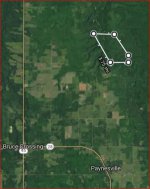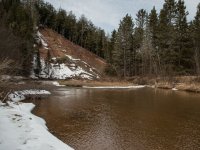Oh what a flashback!
This is too bad. It doesn't seem like
thesse [sic] cabins are really hurting anything.
http://www.freep.com/story/news/col...29/michigan-upper-peninsula-cabins/100594194/
From the article:
"Armas Ojaniemi, 60, of Bruce Crossing …
Like so many in the western Upper Peninsula, his family came over from Finland nearly a century ago, and they’d practically lived in these remote woods ever since …
People built structures in all shapes and sizes most were bare-bones log cabins without power or running water. But they were solid camps that lasted for decades."
Oh that story was quite the flashback for me!
Back at da family farm north of Bruce Crossing, way back in the 1940s or perhaps before, my uncles and several of their neighbors and hunting companions build such a "camp" down along the Middle Branch of the Ontonagon river, below the clay slides.
The cabin was located about a 2½ mile hike from the farm, somewhere roughly in the outlined area on this map, on the west side of the Middle Branch:

It was kind of traditional (click →)
Finnish log construction.
<https: www.nps.gov="" nr="" twhp="" wwwlps="" lessons="" 4logcabins="" 4logcabins.htm="">There were two rooms, each about ≈12'x12', a bunkroom with 2 bunk beds (sleeps 4), and a kitchen which were connected by a narrower ≈8' x 12' "breezeway", open in front and enclosed on the rear, that was used as sheltered firewood storage.
The bunks in the bedroom were at the north end, aligned along the front and back walls, with an old pot bellied wood stove for heating located at the opposite end of the room, adjacent to the center "breezeway" wall.
The front of the cabin faced away from the river, with the back wall of the "breezeway" toward the river.
The kitchen had a sink on the south wall, with a drain plumbed through the wall and toward the river. Also ample storage cabinets above and to either side, well stocked with cookware, dinnerware and utensils. Also a wood fired cook stove, and a 4-place dining table. There was no other plumbing, but fresh water was conveniently available from an artesian well just a short hike away; water was carried from the well to the cabin in the 10 gallon milk cans that were used on the farm.
There were several windows in both the bunkroom and kitchen, complete with glass panes and fancy curtains! Quite nice, for a "primitive" log cabin!
You had to pack in whatever food you planned to have, and pack out any remainder, so as to not feed the mice and other critters.
I spent several nights at the camp with my uncles during deer season in my late teens. On one occasion, we awoke on Sunday morning to stunningly beautiful blue skies, planning on heading back to the farm. But there was a very loud roaring sound, like a flight of B-52s passing nearby at a low altitude. (They really used to do that, around there, too!) We packed up up the two deer and all our of our gear and headed up the clayslide to the west. (Very much like this picture from the article):

When we got about a half mile along the way we discovered what the huge roaring noise was.
Mister Bleezard!
There was one helluva heavy blinding storm headed toward us from the west, and it had already dumped
waist high snow for us to slog through for another two miles to the farm, while hauling two deer carcasses and all of the supplies we packed out! What a trip! What a memory!
Some years later I learned that the camp had been torched. No-one ever knew who did it.

</https:>



 </https:>
</https:>